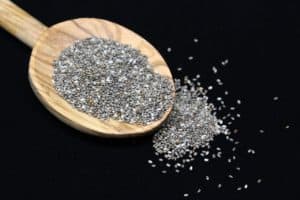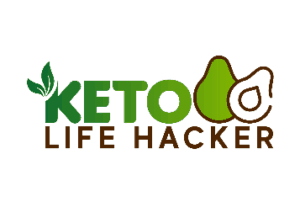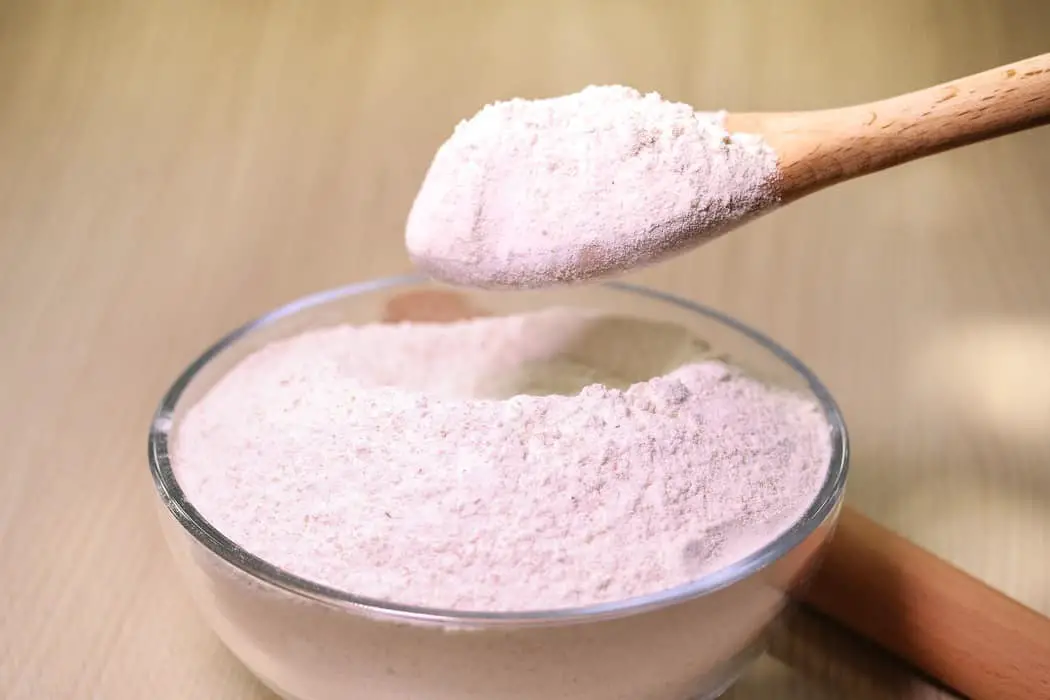As you get more comfortable with the keto diet, you’ll likely want to start getting creative with baked goods, sauces, and other kinds of recipes.
However when you have to stick to a low carb lifestyle, you’ll need to think outside the box. That’s where additives like xanthan gum come in.
When I was first starting out with keto, I really wanted to figure out how to make keto gravy thicker, but after researching xanthan gum, I found that it had a lot more potential than I had first realized.
In this article I’ll take you through exactly what xanthan gum is, and how it can best be used on the keto diet.
What Is Xanthan Gum
At its core, xanthan gum is frequently used as a gluten-free food additive that helps to act as a natural emulsifier and thickening agent. It can be used to substitute wheat flour, tapioca flour, and other thickeners for gluten free, paleo, and keto recipes.
Xanthn gum, derived from the bacteria xanthomonas campestris, is perfectly healthy and FDA approved. The resulting ‘gum’ from this bacteria is characterized as a polysaccharide, which is a string of sugars produced from wheat starch, corn, and whey.
In most types of cooking and baking, this gum should be mixed with water or any type of liquid, so that it can turn into a soluble and fiber-rich gel, which is what gives it that flour-like property.
While it tends to be a little expensive, a little bit of xanthan gum goes a long way, which is why I’m pretty fond of using it for certain dishes compared to other thickening agents.
However you might be asking yourself, “with a product made out of sugar, corn, and wheat, just how keto friendly is it?” Below I’ll explain the exact nutrient breakdown, and clear up any uncertainty about this powerhouse of an additive.
Is Xanthan Gum Keto-Friendly?
Because xanthan gum is a soluble fiber, that means that the 7 grams of carbs per tablespoon that come with it can’t be broken down by your body’s digestive system, meaning it doesn’t contribute to your net carbs – so xanthan gum is keto-friendly.
It’s also calorie free, which is why many people like to use it in place of other keto-friendly flours and thickeners that might rapidly increase their calorie counts.
As a thickener, you only kneed about a pinch, or a quarter tablespoon for most recipes. It’s great for some of the following keto-friendly foods:
- Salad dressings
- Desserts and baked goods
- Sauces and gravies
- Syrups
- Meal replacement shakes
- Foods that traditionally use dough like pizzas
This makes xanthan gum one of my favorite additives for cooking around the holidays. It contributes to great cookies, brownies, pie crust, sauce, and gravy for Thanksgiving and Christmas.
Xanthan gum is also generally pretty easy to find at grocery stores and online. Some of my personally recommended brands that I like to get off Amazon include:
Benefits of Xanthan Gum
Along with being keto-friendly, I’ve found that xanthan gum has a lot of other benefits that make it definitely worth the investment. Some of the major ones are:
-
Lowers blood sugar
This is one of the biggest benefits, and one of the main reasons a lot of people (including myself) choose to use xanthan gum on the keto diet.
Recent studies have shown that xanthan gum can help to reduce blood glucose levels when consumed in large quantities, and may even be able to help those who struggle with diabetes.
The reason for this is because xanthan gum has a similar effect with water as it does with the fluid that’s already in your small intestine. It tends to turn all liquid it comes in contact with into a softer gel, which slows down your overall digestion process, and results in less sugars from food getting absorbed into your blood stream.
-
Has cancer-fighting properties
One recent study in mice that were suffering from melanoma discovered that the introduction of xanthan gum into their diets significantly slowed the growth of cancerous tumors and resulted in prolonged life. However no experiments on humans in this facet have been conducted yet, so the evidence should be taken with a grain of salt when applying it to your own medical situation.
-
Promotes weight loss
Other research has shown that those who eat xanthan gum over other types of flours, starches and thickeners tend to feel fuller after eating it than those who don’t, which contributes to a reduction in overeating, and overall promotes weight loss.
Using xanthan gum as a keto-friendly substitute of course replaces carbs and sugars in a lot of dishes too, which helps your body stay in ketosis and burn off fat more efficiently.
-
Reduces blood cholesterol
Xanthan gum has some suspected impact on blood cholesterol too. While cholesterol is a byproduct of being overweight, and weight loss is directly connected to improved cholesterol levels, xanthan gum may be able to help to an even greater extent.
One recent study found that five men who ate roughly ten times the recommended amount of xanthan gum every day for 23 days were able to decrease their bad levels of cholesterol by roughly percent. However that isn’t recommended for a keto diet, or any diet really, as xanthan gum should be used in moderation with most dishes for both nutrients, digestion, and taste.
- Fixes keto dry mouth
Dry mouth and bad breath is a frequently experienced symptom of ketosis, which can be pretty annoying when starting out. This is often linked to increased levels of acetone (a type of ketone) in the blood
Xanthan gum can help with this by acting as a saliva supplement in people with certain medical conditions, and those who just want to help reduce the effects of dry mouth. Studies however have had mixed results, so xanthan gum should be used in moderation to treat these symptoms.
Side Effects of Xanthan Gum
Despite all the benefits, it’s important to know that xanthan gum isn’t a miracle worker, and does come with certain types of side effects and drawbacks.
That’s not to say that xanthan gum should be avoided, but if you decide to start using xanthan gum, you’ll want to know what side effects to be looking out for.
-
Can cause digestion issues
Xanthan gum’s most frequently exhibited side effect tends to be in the form of an upset stomach.
When consumed in large quantities, it has been known to cause nausea, increased gas and bloating, increased frequency of bowel movements, and diarrhea.
The more intense versions of these side effects generally only present themselves after about 15 grams of xanthan gum is used, which is hard to achieve when using it for baking, cooking, and in sauces and meal replacement shakes.
-
Linked to some food allergies
Xanthan gum does have some links to food allergies as well. Those who have food allergies to specific types of cruciferous vegetables (cauliflower, broccoli, cabbage, kale, etc) might also experience these allergic symptoms with xanthan gum, because it has a similar effect on the body – especially if it is eaten in large quantities and not processed enough before cooking.
Additionally, because it is derived from sugar, wheat, and corn, those who suffer from extreme allergies to any of those base ingredients should avoid xanthan gum, because it still has the potential to carry those allergens in it, even in a heavily processed form.
-
Altered gut bacteria
Like other types of soluble fibers, the altered gut bacteria can actually be a benefit or a drawback, depending on the current state of your gut bacteria and diet. However this can be easily mitigated by using probiotics like kimchi, sauerkraut, kefir, or supplements like Vitamin Bounty Probiotic.
-
Can interfere with certain medications and conditions
Xanthan gum’s ability to lower blood sugar is generally seen as a positive benefit for those trying to lose weight or those with diabetes, but it can be a bad thing for a lot of people on medications that already stabilize their blood sugar levels.
This especially goes for people that are expecting surgery soon, because it can have lasting blood sugar effects that might interrupt what fasting before surgery is trying to accomplish.
Xanthan Gum Alternatives

Because of the potential side effects, it’s important to have other options when trying to replace xanthan gum in keto-friendly recipes. As a proud keto experimenter, I’ve tried all of the following alternatives myself, and they all tend to hold up, with minor differences in benefits and side effects.
-
Guar Gum
Guar gum is another type of fiber that is derived from from guar beans. It is also used as a food stabilizer and emulsifier to help to thicken up the texture of predominantly gluten-free (and keto-friendly) products. It’s fortunately easy to find online and in most grocery stores. And tends to be a little cheaper than xanthan gum per serving. Some of my favorite brands of guar gum include:
-
Thick-it-Up
Dixie Diners’ Thick-It-Up is a pretty popular sugar free concoction within the keto diet community. It’s generally a lot more powerful than xanthan gum when it comes to thickening foods, but a little still goes a long way so you might not want to overdo it.
-
Psyllium Husk
Psyllium husk (often known by the name brand Metamucil) is generally recommended for digestion, because it’s packed full of fiber, but it also can serve as a comparable thickening agent to xanthan gum.
Like xanthan gum, it won’t contribute to your net carbs, and as a bulk-forming laxative, it doesn’t have the same kind of uncomfortable digestive side effects when used in moderate quantities.
-
Gelatin
Gelatin is a great way to bind ingredients together and make them particularly soft and chewy – great for recipes like cookies, brownies, and pizza doughs.
As a protein, it’s derived from boiling the skin, bones, and ligaments of pigs or cows in water. It has a lot of properties that are great for digestion, energy, mental sharpness, and serving as a binding agent in most recipes.
-
Agar Agar
For those that are vegetarian or vegan while following a ketogenic diet, gelatin is obviously a no-go. But agar agar is a great alternative that yields a similar effect.
Agar agar is an additive that is made from seaweed, is low carb and flavorless, and has all the same binding properties as xanthan gum and gelatin. Like xanthan gum, it also has been shown to help stimulate weight loss and regulate digestion.
-
Chia Seeds
These are one of my favorite ways to thicken up a meal. Chia seeds are packed with healthy fats, lots of protein, and very few carbs – making them perfect for the keto diet.
Chia seeds are similar to psyllium husk and xanthan gum because they form a thick gelatinous paste fairly quickly after being mixed with water or most types of liquids. While they have a slightly higher net carb content, they are high in soluble fiber, and still have keto-friendly macros while helping to aid with digestion.
While chia seeds can be used to replace xanthan gum in almost any recipe, I find that they’re particularly effective when replacing meals like oatmeal, pudding, jello, and smoothies and shakes.
One warning though, because of their great ability to thicken up in liquid, they cause more bloating than other xanthan gum alternatives in my experience.
Final Thoughts (150)
Whether you decide to use xanthan gum, or any of the other above keto-friendly additives and thickening agents, it’s always important to keep track of how your body feels after every meal.
With a lot of types of foods and ingredients that your body might not be used to, taking things slow with each experiment will help to avoid unwanted side effects, and maximize your potential benefits.
As long as you stick to under 15 grams of xanthan gum per sitting (which is very easy to do), you should be just fine with incorporating it into your new dishes.

